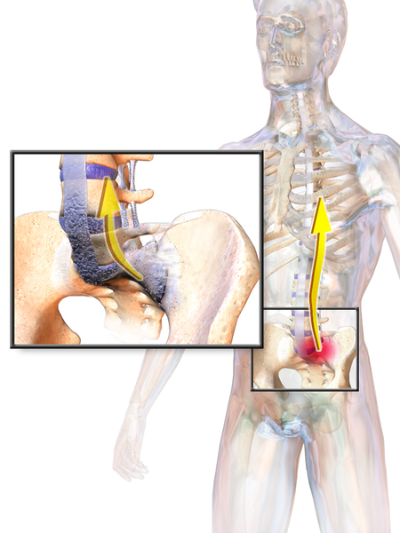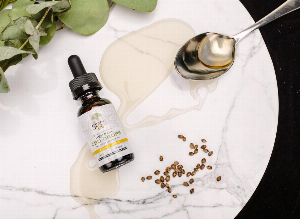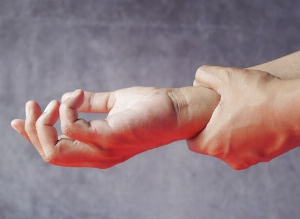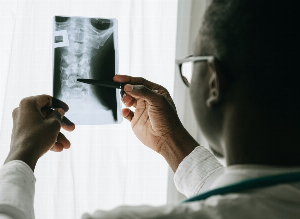Acupuncture Ankylosing Spondylitis Relief Confirmed
Published Jul 30, 2018

Researchers conclude that acupuncture and herbal medicine provide relief for patients with ankylosing spondylitis (AS). Ankylosing spondylitis is a type of arthritis characterized by inflammation of the spine, joints, tendons, or ligaments. Long-term, AS can lead to ankylosis, which is stiffening and often immobility caused by fusion of bones. Ankylosing spondylitis is categorized in Traditional Chinese Medicine in several domains: lower back pain, kyphosis, spinal rigidity. In the advanced stages of the illness when bone fusion is present, it is categorized as zhu jie yang (bamboo spine).
 Clinical trials at the Shaanxi Baoji Traditional Chinese Medicine Hospital determined that acupuncture and herbal medicine improve bone and muscle activity for AS patients with a three month course of treatment. The research determined that patients had significant reductions in pain levels and subsequent improvements in activities of daily living. [1]
Clinical trials at the Shaanxi Baoji Traditional Chinese Medicine Hospital determined that acupuncture and herbal medicine improve bone and muscle activity for AS patients with a three month course of treatment. The research determined that patients had significant reductions in pain levels and subsequent improvements in activities of daily living. [1]
Jilin General Hospital researchers also tested the efficacy of acupuncture and herbal medicine. Using a protocol of warm needle Huatuojiaji acupoints and Lei Wu Fang Chinese herbal medicine steam baths, patients improved significantly. [2]
Many patients experienced significant recuperation levels, with no pain or joint inflammation and restoration of normal joint functioning. Other patients had significant pain inflammation reductions. The ineffective rate was relatively low. Let’s look at the results.
Eighty AS patients were selected from Jilin General Hospital between January 2015 and January 2017. They were randomly divided into 2 groups, the observation group and the control group. Patients in the control group received treatment with sulfasalazine for 3 months. Sulfasalazine is derived from salicylic acid (found in aspirin) combined with sulfapyridine, an antibiotic. The drug reduces inflammation and is used for the treatment of Crohn’s disease, rheumatoid arthritis, and ankylosing spondylitis.
The treatment group received warm needle acupuncture and Chinese herbal medicine therapy. The primary acupoints were Huatuojiaji points applied to affected areas. Secondary acupuncture points were added to the following:
Dazhui GV14 (Hundred Taxations)
Ganshu BL18 (Liver Shu)
Dazhu BL11 (Great Shuttle)
Shenshu BL23 (Kidney Shu)
Patients were instructed to rest in a supine position for the treatment. After disinfection of the local skin areas, acupuncture needles were inserted toward the direction of the spine for all Huatuojiaji acupoints. Moxa was added to the needles, ignited, and supervised. Each acupuncture session was 30 minutes. Patients had one session per day for 20 consecutive days.
Treatment group patients also received Chinese herbal medicine soaking baths. The herbal medicine prescription was Lei Wu Fang, which consisted of the following ingredients:
Shenjincao (Common Clubmoss Herb), 20 grams
Qingfengteng (Sinomenii caulis), 20 grams
Dahuang (Rheum officinal), 15 grams
Tougucao (Tuberculate speranskia herb), 15 grams
Leigongteng (Tripterygium wilfordii), 15 grams
Fengfang (Nidus vespae), 15 grams
Buguzhi (Psoraleae fructus), 12 grams
Chuanwu (Monkshood), 10 grams
Caowu (Radix aconiti agrestis), 10 grams
Huajiao (Chinese prickly ash), 10 grams
Ruxiang (Baswellia carterii), 10 grams
Moyao (Commiphora myrrha), 10 grams
Mangxiao (Glauber's salt), 10 grams
The ingredients were boiled with 3000–4000 ml of water. Patients then soaked in a steam bath containing the warm herbal decoction. The temperature of the tub was adjusted according to each patient’s condition. Each soaking treatment lasted for 30 minutes. Patients had one session per day for 20 consecutive days. Efficacy of the treatment was classified as follows:
Very effective: the patient did not experience any pain or other symptoms of joint inflammation after the treatment course. Joint functions were restored to normal and the patient was able to carry out daily tasks and work.
Effective: pain and other symptoms of joint inflammation were greatly reduced. Major joint functions were restored. Patient had limited capability in handling daily tasks and work.
Ineffective: the patient did not improve significantly. [3]
Efficacy was also evaluated using the following measures:
The international AS evaluation criteria (AS score)
The patient's overall evaluation index (PGA index)
The Bath Ankylosing Spondylitis Functional Index (BASFI) [4]
The total effective rate for the treatment group, combining both the very effective and effective rates was 95%. The total effective rate in the drug control group was 77.5%. The results demonstrate that a combination of acupuncture and herbal medicine is an effective approach to patient care for patients with ankylosing spondylitis.
Notes
1. Wang KJ, Zhao L, Zhang H. Clinical Observation of Warm Acupuncture and Chinese Herbal Fumigation to treating active Ankylosing Spondylitis [J] Modern Journal of Integrated Traditional Chinese and Western Medicine,2016,25(31):3434-3436.
2. Pu Quanjiang. Clinical Observation of Warm Acupuncture and Herbal Fumigation to treat Ankylosing Spondylitis [J] World Latest Medicine Information, 2018, 18 (5): 130.
3. Wang YL, Ren CJ. Therapeutic Effect of Warm Acupuncture and Acupoint Injection to treat Ankylosing Spondylitis [J] Modern Journal of Integrated Traditional Chinese and Western Medicine,2014,23(6):635-637.
4. Yuan GH. Clinical Observation of Tuina and Warm Acupuncture to treat Lumbar Intervertebral Disc Protrusion [J] Journal of Yichun University,2014,36(3):77-78.
Health CMI
Comments
You will also like

Ankylosing Spondylitis: More Than Fifteen Years of Pain to Finally Live a Better Life
Oct 16, 2018 • 5 comments

 Facebook
Facebook Twitter
Twitter

